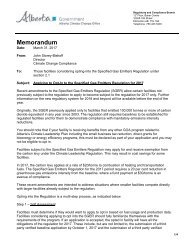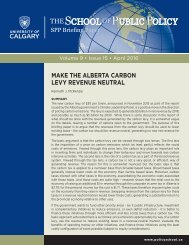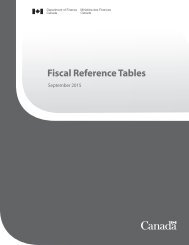GST/HST Credit
rc4210-16e
rc4210-16e
You also want an ePaper? Increase the reach of your titles
YUMPU automatically turns print PDFs into web optimized ePapers that Google loves.
Definitions<br />
Adjusted family net income – this is your family net<br />
income (defined below) minus any universal child care<br />
benefit (UCCB) and registered disability savings plan<br />
(RDSP) income received plus any UCCB and RDSP<br />
amounts repaid.<br />
Common-law partner – this applies to a person who is not<br />
your spouse (defined below), with whom you are living in<br />
a conjugal relationship, and to whom at least one of the<br />
following situations applies. He or she:<br />
a) has been living with you in a conjugal relationship,<br />
and this current relationship has lasted at least<br />
12 continuous months;<br />
Note<br />
In this definition, 12 continuous months includes<br />
any period you were separated for less than 90 days<br />
because of a breakdown in the relationship.<br />
b) is the parent of your child by birth or adoption; or<br />
c) has custody and control of your child (or had<br />
custody and control immediately before the child<br />
turned 19 years of age) and your child is wholly<br />
dependent on that person for support.<br />
Family net income – this is your net income (line 236 of<br />
your income tax and benefit return) added to the net<br />
income of your spouse or common-law partner, if you have<br />
one. Family net income does not include your child’s net<br />
income.<br />
If you or your spouse or common-law partner were<br />
non-residents of Canada for part or all of the year, family<br />
net income includes your or your spouse’s or common-law<br />
partner’s income from all sources, both inside and outside<br />
Canada, for any part of the year either of you were not<br />
residents of Canada.<br />
Separated – you are separated when you start living<br />
separate and apart from your spouse or common-law<br />
partner because of a breakdown in the relationship for a<br />
period of at least 90 days and you have not reconciled.<br />
Once you have been separated for 90 days (because of a<br />
breakdown in the relationship), the effective day of your<br />
separated status is the date you started living separate and<br />
apart.<br />
Spouse – this applies only to a person to whom you are<br />
legally married.<br />
What is the <strong>GST</strong>/<strong>HST</strong> credit?<br />
T<br />
he <strong>GST</strong>/<strong>HST</strong> credit is a non-taxable quarterly payment<br />
that helps individuals and families with low and<br />
modest incomes offset all or part of the goods and services<br />
tax/harmonized sales tax (<strong>GST</strong>/<strong>HST</strong>) that they pay.<br />
Are you eligible for the credit?<br />
Y<br />
ou are eligible for this credit if you are a resident of<br />
Canada for income tax purposes in the month before<br />
and at the beginning of the month in which we make a<br />
payment (see “When do we pay your credit?” on page 8),<br />
and at least one of the following applies:<br />
■ you are 19 years of age or older;<br />
■ you have (or had) a spouse or common-law partner; or<br />
■ you are (or were) a parent and live (or lived) with your<br />
child.<br />
Note<br />
If you will turn 19 years of age before April 2017, see<br />
“Will you turn 19 years of age before April 2017?” on<br />
page 6.<br />
Generally, you are not eligible for the <strong>GST</strong>/<strong>HST</strong> credit if<br />
at the beginning of the month in which we make a<br />
quarterly payment, any of the following apply:<br />
■ you are not a resident of Canada for income tax<br />
purposes;<br />
■ you do not have to pay tax in Canada because you are an<br />
officer or servant of another country (such as a diplomat)<br />
or a family member or employee of such a person; or<br />
■ you are confined to a prison or similar institution for a<br />
period of 90 consecutive days or more.<br />
Note<br />
You cannot get the credit for a spouse, common-law<br />
partner, or child who meets any of these conditions at<br />
the beginning of the month in which we make a<br />
quarterly payment.<br />
How do you get the credit?<br />
To get the <strong>GST</strong>/<strong>HST</strong> credit, including any related<br />
provincial credits, you have to file an income tax and<br />
benefit return for 2015, even if you have not received<br />
income in the year.<br />
We will let you know in July 2016 how much you will get<br />
and how we calculated it. For more information, see “How<br />
do we calculate your credit?” on page 6.<br />
If you are a new resident of Canada and you want to get<br />
the <strong>GST</strong>/<strong>HST</strong> credit, fill out Form RC151, <strong>GST</strong>/<strong>HST</strong> credit<br />
application for individuals who become residents of Canada, for<br />
the year that you became a resident of Canada. For more<br />
information for newcomers to Canada, go<br />
to cra.gc.ca/newcomers or see Pamphlet T4055, Newcomers<br />
to Canada.<br />
You have up to three years to ask for a retroactive payment.<br />
If you did not apply for the credit on your 2013 income tax<br />
and benefit return or have not filed a 2014 return within<br />
the three-year period, you can send us a request under<br />
the taxpayer relief provisions of the Income Tax Act. For<br />
more information, go to cra.gc.ca/fairness or see<br />
Information Circular IC07-1, Taxpayer Relief Provisions.<br />
4<br />
cra.gc.ca







